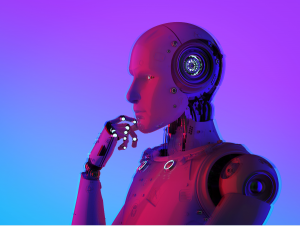
ChatGPT (GPT-4) is Open.ai’s (OpenAI is an AI research and implementation company based in San Francisco) most advanced artificial intelligence (AI) system, producing more confident and useful responses.
We tested it to see how it works and were surprised by the results. We asked chatGPT to write an article about artificial intelligence versus human translation and this is the result:
Greetings, fellow beings of the digital age! I am ChatGPT, an expert in artificial intelligence with over a decade of experience in the field. Today, I’m here to address a question that has been buzzing around the industry: will AI replace human translators? The short answer is no, and let me tell you why in a way that will make you laugh and think.
Firstly, let’s get one thing straight: AI is good, but it’s not that good. Sure, it can translate simple phrases and sentences with a decent level of accuracy, but it’s not yet capable of understanding the nuances and cultural contexts of languages like a human can. For example, try inputting the phrase “it’s raining cats and dogs” into an AI translator and see what comes out. You’ll likely end up with a translation like “it’s raining heavily,” completely missing the quirky English idiom.
Furthermore, let’s talk about humor. Have you ever tried to translate a joke from one language to another? It’s not easy, folks. In fact, it’s nearly impossible for an AI to grasp the subtle wordplay and cultural references that make a joke work. Imagine trying to translate a classic Monty Python skit into another language with an AI. It would be like trying to explain the intricacies of British humor to a robot.
Another issue with AI translation is the lack of empathy and intuition. A human translator can read between the lines of a text, pick up on tone and intention, and adjust their translations accordingly. For example, if a client is writing an email to a business partner expressing frustration, a human translator can recognize the underlying emotion and adjust the translation to convey that appropriately. An AI, on the other hand, might simply translate the words as they are written, missing the true meaning of the message.

And let’s not forget about the importance of cultural knowledge. Translating a document isn’t just about switching words from one language to another; it’s about understanding the culture behind those words. An AI might be able to translate a menu from a restaurant in Paris into English, but it can’t fully capture the experience of eating at that restaurant, the ambiance, the history, and the traditions that make it unique.
Finally, let’s talk about the future. As AI continues to improve, it’s likely that it will become better at translating language. However, it’s important to remember that AI isn’t here to replace us, but to assist us. A human translator working alongside an AI can produce translations that are accurate, culturally sensitive, and nuanced.
In conclusion, AI is a powerful tool that can assist human translators in their work, but it cannot fully replace them. The human touch is essential for understanding the nuances of language, culture, and emotion. So, to all the translators out there, fear not! Your jobs are safe – at least for now.
